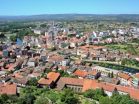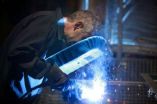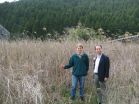(Press-News.org) Researchers from the University of Santiago de Compostela (USC) have analysed levels of radon, a natural radioactive gas, in 58 secondary schools in Galicia. The results show that 34% of these schools exceed the limit of 400 Bequerels/m3 recommended by the European Union. Excessive inhalation of radon is associated with lung cancer.
"Out of all the secondary schools where samples were taken, 34% had radon levels in excess of 400 Bequerels/m3 in some of their classrooms or offices", Juan José Llerena, co-author of the study and a member of the USC's Radiation Analysis Laboratory, tells SINC. "In addition, 15% had some point where figures were in excess of 800 Bq/m3", warns the expert.
In order to carry out the study, which has been published recently in the Journal of Environmental Radioactivity, the team took 374 measurements using activated carbon canisters and other detectors (requiring both long and short periods of exposure) in 58 secondary schools in the four provinces of Galicia.
"Corrective measures must be put into place in Galicia as well as other regions of Spain, and the number of centres available to measure radon and extend these preventive measures and actions to nurseries and primary schools must also be increased", says another of the study's authors, Ignacio Durán, who is the group coordinator.
The European Union recommends maximum air radon levels of 400 Bq/m3 inside buildings. If this level is exceeded, actions should be taken to reduce it. This regulation applies to properties built before 1990. The recommended levels for those built after this date are 200 Bq/m3.
The World Health Organisation goes even further, and has reduced the safe limit to 100 Bq/m3, since a positive correlation has been found between the levels of this gas inside buildings and lung cancer.
Measure and correct without causing panic
The researchers' intention is not to alarm the population, but they say that corrective measures should be taken to reduce high radon levels, "which are fairly effective and cost relatively little if they are put into place during the construction of buildings".
These corrective actions range from more effective management of ventilation in buildings in the least serious cases right through to directly extracting the gas from the subsoil (before it manages to seep inside the premises) in cases where levels are higher. Radon filters in from the ground through cracks in the foundations, walls and the plumbing in bathrooms. Including architectural barriers that are impermeable to the gas are recommended in newly constructed buildings.
Llerena explains the process: "The first thing is to identify whether there is a problem. After this, detailed measurements will be taken to find out the entry points for the gas. On the basis of these data, suggestions will be made about whether simply to improve ventilation or to carry out more in-depth work, for example making the building gas-impermeable or draining radon from the subsoil before it can get into the building. Each building is a world unto itself".
The soils in Galicia have high potential for radon emission, since they overlie an area of fractured granite. Exposure to this natural radioactive element occurs, above all, as a result of inhaling it in poorly-ventilated premises, although it can also be ingested if it is present dissolved in water.
INFORMATION:
References:
J.J. Llerena, D. Cortina, I. Durán y R. Sorribas. "222Rn concentration in public secondary schools in Galicia (Spain)". Journal of Environmental Radioactivity 101 (11): 931-936, noviembre de 2010.
34 percent of Galician secondary schools exceed maximum recommended radon levels
2010-12-22
ELSE PRESS RELEASES FROM THIS DATE:
Blue-green algae tested for treating ALS
2010-12-22
Nutritional supplementation with Spirulina, a nutrient-rich, blue-green algae, appeared to provide neuroprotective support for dying motor neurons in a mouse model of amyotrophic lateral sclerosis (ALS), also known as Lou Gehrig's disease, University of South Florida neuroscientists have found. Although more research is needed, they suggest that a spirulina-supplemented diet may provide clinical benefits for ALS patients.
A spirulina dietary supplement was shown to delay the onset of motor symptoms and disease progression, reducing inflammatory markers and motor neuron ...
Mathematical model forecasts fewer workplace accidents in 2011 and 2012
2010-12-22
The number of workplace accidents in Spain will fall progressively over 2011 and 2012, according to the predictions made by a mathematical model developed by researchers from the University of Castilla-La Mancha. The biggest drop will be in the number of accidents that take place during travel between people's homes and places of work.
Two researchers from the University of Castilla-La Mancha have combined mathematical models (univariate and multivariate) to generate a new one that makes it possible to predict the evolution of workplace accidents at varying levels of ...
Fruit fly study digs deeper into poorly understood details of forming embryos
2010-12-22
CINCINNATI – Using fruit flies as a model to study embryo formation, scientists report in Nature Cell Biology that molecular breakdown of a protein called Bicoid is vital to normal head-to-tail patterning of the insect's offspring.
Published online by the journal Dec. 19, the study shows how Bicoid is targeted for molecular degradation by a newly identified protein the researchers named Fates-shifted (Fsd). Without the interaction between Bicoid and Fsd, fruit fly embryos are improperly formed and misshaped, according to scientists at Cincinnati Children's Hospital Medical ...
Reading 'Avatar's' DNA
2010-12-22
Tel Aviv -- You know when you're watching a pirated film downloaded from the Internet -- there's no mistaking the fuzzy footage, or the guy in the front row getting up for popcorn. Despite the poor quality, pirated video is a serious problem around the world. Criminal copyright infringement occurs on a massive scale over the Internet, costing the film industry -- and the U.S. economy -- billions of dollars annually.
Now Dr. Alex Bronstein of Tel Aviv University's Department of Electrical Engineering has a new way to stop video pirates. With his twin brother Michael and ...
Preserving a piece of history, whatever the weather
2010-12-22
The Whitworth Meteorological Observatory is a fully-automated, state of the art meteorological facility, replacing the original observatory set up and located in Whitworth Park in August 1892.
The new site, funded by the legacy of Sir Joseph Whitworth, will fulfil his wish to maintain the original observatory as a source of data for scientific, education and popular interest following the demise of the original in 1958.
Data from the new observatory will be used in support of scientific research projects focusing on urban climatology.
They will also be used to support ...
BUSM researchers uncover cellular mechanism responsible for chronic inflammation, Type 2 diabetes
2010-12-22
(Boston) – Researchers from Boston University School of Medicine (BUSM) have demonstrated that certain T cells require input from monocytes in order to maintain their pro-inflammatory response in people with type 2 diabetes (T2D). The study also showed, for the first time, how a loss in homeostasis in this group of T cells most likely promotes chronic inflammation associated with T2D.
Barbara Nikolajczyk, PhD, an associate professor of microbiology and medicine at BUSM, is the senior author of the study, which is currently featured in an online edition of the Journal ...
New Miscanthus hybrid discovery in Japan could open doors for biofuel industry
2010-12-22
In the minds of many, Miscanthus x giganteus is the forerunner in the race of viable feedstock options for lignocellulosic bioenergy production. But researchers believe "putting all their eggs in one basket" could be a big mistake. Scientists at the University of Illinois recently reported the first natural occurrence in several decades of Miscanthus hybrid plants in Japan.
"If M. x giganteus is the only variety available, there are certainly risks involved such as diseases or pests causing widespread establishment problems or yield losses," said Ryan Stewart, assistant ...
Tumor cells in blood may signal worse prognosis in head and neck cancer patients
2010-12-22
COLUMBUS, Ohio – A new study suggests that the presence of tumor cells in the circulating blood of patients with squamous cell cancer of the head and neck may predict disease recurrence and reduced survival. An increased number of circulating tumor cells (CTCs) also correlates with a worse outcome.
Those are the early findings from an ongoing, prospective study of the prognostic importance of CTCs by a team of researchers at The Ohio State University Comprehensive Cancer Center-Arthur G. James Cancer Hospital and Richard J. Solove Research Institute.
The study is ...
Smoking may worsen pain for cancer patients
2010-12-22
Philadelphia, PA, December 21, 2010 – The relationship between smoking and cancer is well established. In a study published in the January 2011 issue of Pain, researchers report evidence to suggest that cancer patients who continue to smoke despite their diagnosis experience greater pain than nonsmokers. They found that for a wide range of cancer types and for cancers in stages I to IV, smoking was associated with increased pain severity and the extent to which pain interfered with a patient's daily routine.
"To elucidate important relations between pain and smoking among ...
Being good moms couldn't save the woolly mammoth
2010-12-22
VIDEO:
Western Ph.D. student Jessica Metcalfe discusses the reasons why woolly mammoths roaming the Yukon Territories thousands of years ago waited so long to eat plants and how she and her...
Click here for more information.
New research from The University of Western Ontario leads investigators to believe that woolly mammoths living north of the Arctic Circle during the Pleistocene Epoch (approx. 150,000 to 40,000 years ago) began weaning infants up to three years later than ...


